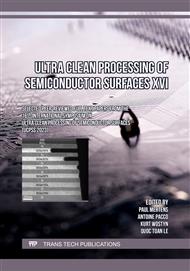p.99
p.105
p.111
p.117
p.123
p.131
p.137
p.143
p.149
Insights into FinFET Structure Collapse: A Reactive Force Field-Based Molecular Dynamics Investigation
Abstract:
As miniaturization progresses, pattern collapse during the drying step of wet cleaning processes has become a critical issue in the semiconductor industry. In this study, we used reactive molecular dynamics simulations to analyze pattern collapse, with a focus on bondings and reactions. To simulate pattern deformation during the drying process of wet cleaning, we created a FinFET model as a HAR structure. The surface of this model was terminated with hydrogen atoms. The widths between the patterns were changed in order to create a Laplace pressure difference when water molecules were placed on the surface. The model was simulated by placing water molecules up to half the height of the pattern. As a result, the pattern was deformed. Furthermore, by removing water molecules and changing the Laplace pressure balance, it was found that the pattern contacted each other at the tip. The pattern remained in contact when water molecules were removed from the model. In the contact area, the covalent bonds, such as Si-Si and Si-O-Si, were not formed, but instead, hydrogen-to-hydrogen van der Waals bonds were formed between patterns. We calculated the total van der Waals forces between hydrogen atoms at the contact surfaces using the Hamaker equation and calculated the elastic force of the patterns using the beam deflection formula. Our calculations showed that the total van der Waals forces between hydrogen atoms at the contact surfaces were larger than the elastic force of the patterns, indicating that van der Waals forces could be a factor in maintaining the contact of the patterns.
Info:
Periodical:
Pages:
123-128
Citation:
Online since:
August 2023
Authors:
Price:
Сopyright:
© 2023 Trans Tech Publications Ltd. All Rights Reserved
Share:
Citation:


